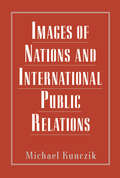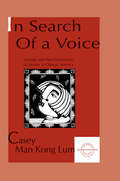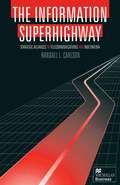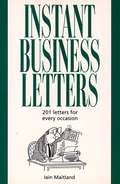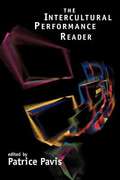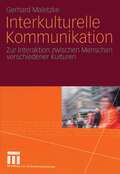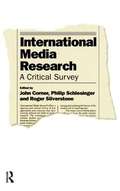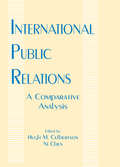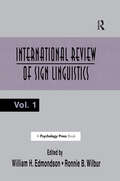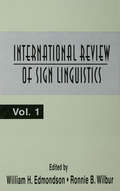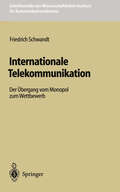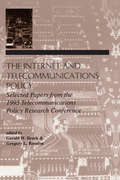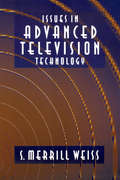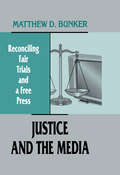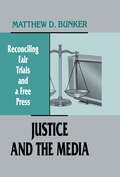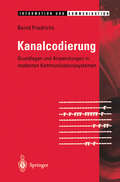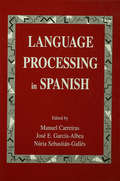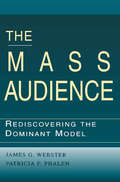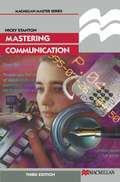- Table View
- List View
Images of Nations and International Public Relations (Routledge Communication Series)
by Michael KunczikThis volume addresses the importance of images of nations in international relations. One fundamental assumption is that the behavior of states is not the same as that of individuals. States are social systems whose behavior as a rule directly corresponds neither to the motives of their respective leaders nor to those of their populations. However, it is also self-evident that international activities always depend on personal relationships. The studies presented relate to more or less deliberate attempts to induce change in images. Given the interdisciplinary nature of the subject matter, findings made in public relations, advertising research, prejudice research and other fields are also taken into account. Very often it is impossible to distinguish between the image of the nation-state and the images of big enterprises such as Krupp, Ford, or Coca Cola. For this reason, the country of origin effect is also discussed.
in Search of A Voice: Karaoke and the Construction of Identity in Chinese America (Everyday Communication Series)
by Casey M.K. LumOriginating in Japan early in the 1970s as a simple sing-along technology, karaoke has become a hybrid media form designed to integrate mass-mediated popular music, video images, computer graphics, and the live musical performance of its human users. Not only has karaoke become a multimillion-dollar entertainment industry, its varied uses have also evolved into diverse popular cultural and social practices among many people around the world. Based on a two-year ethnographic study, this book offers a penetrating analysis of how karaoke is used in the expression, maintenance, and (re)construction of social identity as part of the Chinese American experience. It also explores the theoretical implications of interaction between the media audience and karaoke as both an electronic communication technology and a cultural practice. This book analyzes the social origins of karaoke and the dramaturgical characteristics of karaoke events, and explains how various musical genres are reframed as karaoke music. It also visits the numerous karaoke scenes in their natural context -- the sites of the actual consumption of media products, such as expensive private homes and fancy hotel ballrooms in the affluent suburbs of New Jersey, working-class restaurants and nightclubs in the multiethnic neighborhoods in Flushing, Queens, and Cantonese opera music clubs in New York's Chinatown. Finally, the book offers an intimate analysis of how karaoke has been adopted by several interpretive communities of first-generation Chinese immigrants not only as popular entertainment but also as a means to help (re)define their social identity and way of life.
in Search of A Voice: Karaoke and the Construction of Identity in Chinese America (Everyday Communication Series)
by Casey M.K. LumOriginating in Japan early in the 1970s as a simple sing-along technology, karaoke has become a hybrid media form designed to integrate mass-mediated popular music, video images, computer graphics, and the live musical performance of its human users. Not only has karaoke become a multimillion-dollar entertainment industry, its varied uses have also evolved into diverse popular cultural and social practices among many people around the world. Based on a two-year ethnographic study, this book offers a penetrating analysis of how karaoke is used in the expression, maintenance, and (re)construction of social identity as part of the Chinese American experience. It also explores the theoretical implications of interaction between the media audience and karaoke as both an electronic communication technology and a cultural practice. This book analyzes the social origins of karaoke and the dramaturgical characteristics of karaoke events, and explains how various musical genres are reframed as karaoke music. It also visits the numerous karaoke scenes in their natural context -- the sites of the actual consumption of media products, such as expensive private homes and fancy hotel ballrooms in the affluent suburbs of New Jersey, working-class restaurants and nightclubs in the multiethnic neighborhoods in Flushing, Queens, and Cantonese opera music clubs in New York's Chinatown. Finally, the book offers an intimate analysis of how karaoke has been adopted by several interpretive communities of first-generation Chinese immigrants not only as popular entertainment but also as a means to help (re)define their social identity and way of life.
The Information Superhighway: Strategic Alliances in Telecommunications and Multimedia
by Randall L. CarlsonThis text explores the shape of the partnerships between cable, TV, entertainment and multi-media companies, and how they lower entry fees, consolidate technologies and influence regulatory structure.
Instant Business Letters
by Iain MaitlandEverything you need to know to become a first-class letter writer. Includes over 200 examples of business letters that can be used immediately or amended to suit your own purposes.
The Intercultural Performance Reader (PDF)
by Patrice PavisWhat can performers in the West learn from the technical performance traditions of Africa and Asia? The Intercultural Performance Handbook opens up a new world of technique for performers. The first ever full-length, fully illustrated manual for practitioners, it provides: A guide to the physical, vocal and improvisational dynamics of non-Western performance A new vocabulary with which to interpret plays from around the globe. Games to use for exploring rhythm, movement, balance, tension and gesture, breathwork, stylisation, and the use of the voice A practical, hands-on approach to creating vibrant theatrical work Studies on intercultural performance are usually written by scholars and researchers. John Martin explains the definition and development of intercultural performance from the perspective of an experienced practitioner. He provides exercises, practical advice, and a clear training process for the inquiring actor or director. The book is a process of discovery, carefully written so as to develop understanding and move towards empowerment for the adventurous theatre-maker.
Interkulturelle Kommunikation: Zur Interaktion zwischen Menschen verschiedener Kulturen
by Gerhard MaletzkeWenn Menschen verschiedener Kulturen einander begegnen, ergeben sich vielfache Kommunikationsschwierigkeiten. Als Ursachen dafür lassen sich Strukturmerkmale herausarbeiten, in denen sich Kulturen voneinander unterscheiden. Die Kenntnis dieser Merkmale erleichtert es, Angehörige fremder Kulturen zu verstehen, Kommunikationsprobleme abzubauen und in einer fremden Kultur mit den einheimischen Denk- und Verhaltensweisen besser zurechtzukommen.
International Media Research: A Critical Survey (PDF)
by John Corner Roger Silverstone Philip SchlesingerInternational Media Research offers a rigorous and critical review of key approaches and concerns that have recently defined the field of media research. In this clearly argued collection of essays, the contributors analyze and reflect upon dominant themes and debates that have made media research an increasingly important element of cultural theory. The volume begins with a critical evaluation of the work of the leading media scholar, Elihu Katz, and continues with an exploration of the relationship between media studies and adjacent disciplines: cultural studies and gender and sexuality. Contributors drawn from Britain, America, Canada and Belgium consider the relationships between media research and media policy in different national and international contexts. Focusing on the European Union, East-Central Europe, North America and Latin America, chapters assess the impact of social, economic and political circumstances on policy debates and the shaping of the research agenda. The final chapter adopts a transatlantic perspective in tracing and analysing the history of the media's role in reporting war. International Media Research offers a rigorous and critical review of key approaches and concerns that have recently defined the field of media research. In this clearly argued collection of essays, the contributors analyze and reflect upon dominant themes and debates that have made media research an increasingly important element of cultural theory. The volume begins with a critical evaluation of the work of the leading media scholar, Elihu Katz, and continues with an exploration of the relationship between media studies and adjacent disciplines: cultural studies and gender and sexuality. Contributors drawn from Britain, America, Canada and Belgium consider the relationships between media research and media policy in different national and international contexts. Focusing on the European Union, East-Central Europe, North America and Latin America, chapters assess the impact of social, economic and political circumstances on policy debates and the shaping of the research agenda. The final chapter adopts a transatlantic perspective in tracing and analysing the history of the media's role in reporting war.
International Public Relations: A Comparative Analysis
by Hugh M. Culbertson Ni ChenAs a formal occupation, public relations grew primarily in the United States through much of the twentieth century. In recent years, however, it has spread rapidly throughout the world. Broad outlines on how public relations practices differ from country to country have only recently begun to take shape in scholarly writing about the field. The existing literature on international public relations tends to focus on how those working for western organizations --particularly multi-national corporations--can best practice abroad. Although useful, such writings tend to focus on adaptation of western approaches, not on development of new ones designed specifically for varied sociocultural settings around the world. The editors have produced this book for a number of reasons. There has been tremendous growth in the teaching of public relations around the world--enhancing practice in many countries outside North America. There has also been rapid growth in the number of professors who demand theoretical perspectives which might facilitate a unified comparative analysis across countries and regions. Only a few U.S. universities--six documented in this book--now teach courses formerly called "International Public Relations." However, many professors are going abroad to teach and do research. This suggests increased interest in and a need for courses dealing with international public relations. Furthermore, there is a dearth of literature dealing in depth with international PR, an important component of international communication. This appears to be the first book-length comparative analysis of public relations as practiced in various countries and regions around the world. Although existing books on international PR focus largely on ways in which western practitioners, employers, and clients can operate effectively in other countries, this volume views public relations in each country or region covered from the perspective of practitioners in that country. It contains six chapters designed to provide a theoretical anchor for the 14 country and region analyses. Given the intense interest in public relations education as a factor in professional enhancement, it also discusses issues and practices relating to education.
International Public Relations: A Comparative Analysis
by Hugh M. Culbertson Ni ChenAs a formal occupation, public relations grew primarily in the United States through much of the twentieth century. In recent years, however, it has spread rapidly throughout the world. Broad outlines on how public relations practices differ from country to country have only recently begun to take shape in scholarly writing about the field. The existing literature on international public relations tends to focus on how those working for western organizations --particularly multi-national corporations--can best practice abroad. Although useful, such writings tend to focus on adaptation of western approaches, not on development of new ones designed specifically for varied sociocultural settings around the world. The editors have produced this book for a number of reasons. There has been tremendous growth in the teaching of public relations around the world--enhancing practice in many countries outside North America. There has also been rapid growth in the number of professors who demand theoretical perspectives which might facilitate a unified comparative analysis across countries and regions. Only a few U.S. universities--six documented in this book--now teach courses formerly called "International Public Relations." However, many professors are going abroad to teach and do research. This suggests increased interest in and a need for courses dealing with international public relations. Furthermore, there is a dearth of literature dealing in depth with international PR, an important component of international communication. This appears to be the first book-length comparative analysis of public relations as practiced in various countries and regions around the world. Although existing books on international PR focus largely on ways in which western practitioners, employers, and clients can operate effectively in other countries, this volume views public relations in each country or region covered from the perspective of practitioners in that country. It contains six chapters designed to provide a theoretical anchor for the 14 country and region analyses. Given the intense interest in public relations education as a factor in professional enhancement, it also discusses issues and practices relating to education.
International Review of Sign Linguistics: Volume 1
by William H. Edmondson Ronnie B. WilburThe International Review of Sign Linguistics -- which replaces the International Journal of Sign Linguistics -- is planned as an annual series publishing the most up-to-date scholarly work in all aspects of sign language linguistics. There is no other comparable publication. The international community of sign linguists needs an authoritative outlet for its research findings. IRSL provides this forum for sign linguists, and for those mainstream linguists increasingly interested in sign languages, by filling the void in linguistic analysis of sign language -- as opposed to other concerns, such as deaf education, teaching sign languages, training interpreters, etc. -- and by pulling together in one place linguistic dialogue on sign language structure. It provides a scholarly focus for all linguists who need to remain current with developments in sign linguistics. For the growing international community, IRSL provides a focus for developments within the field and for advancement of the field in scattered research communities. This review contains seven articles covering a wide range of linguistic areas, signed languages, and theoretical perspectives. Papers deal with the lexicon, morphology, phonology, syntax, pragmatics, prosody, metalinguistic issues, and socio-historical change. Five signed languages are represented including American, German, Australian, French, and Israeli.
International Review of Sign Linguistics: Volume 1
by William Edmondson Ronnie B. WilburThe International Review of Sign Linguistics -- which replaces the International Journal of Sign Linguistics -- is planned as an annual series publishing the most up-to-date scholarly work in all aspects of sign language linguistics. There is no other comparable publication. The international community of sign linguists needs an authoritative outlet for its research findings. IRSL provides this forum for sign linguists, and for those mainstream linguists increasingly interested in sign languages, by filling the void in linguistic analysis of sign language -- as opposed to other concerns, such as deaf education, teaching sign languages, training interpreters, etc. -- and by pulling together in one place linguistic dialogue on sign language structure. It provides a scholarly focus for all linguists who need to remain current with developments in sign linguistics. For the growing international community, IRSL provides a focus for developments within the field and for advancement of the field in scattered research communities. This review contains seven articles covering a wide range of linguistic areas, signed languages, and theoretical perspectives. Papers deal with the lexicon, morphology, phonology, syntax, pragmatics, prosody, metalinguistic issues, and socio-historical change. Five signed languages are represented including American, German, Australian, French, and Israeli.
Internationale Telekommunikation: Der Übergang vom Monopol zum Wettbewerb (Schriftenreihe des Wissenschaftlichen Instituts für Kommunikationsdienste #18)
by Friedrich SchwandtThe Internet and Telecommunications Policy: Selected Papers From the 1995 Telecommunications Policy Research Conference
by Gerald W. Brock Gregory L. RosstonThis book is based on the Telecommunications Policy Research Conference which reports on research into telecommunications policy issues. While the conference is now a respectable 23 years old, this is only the second printed edition of selected papers. A new law, the Telecommunications Act of 1996, accelerated the process of integration in the communication industry and made major revisions to the Communications Act of 1934 that increase the incentive for integration within the industry. Although the papers in this volume were written prior to the passage of the new law, their importance is merely enhanced by it. They deal with fundamental, complex policy problems that arise when previously separate segments of the telecommunications industry are integrated, rather than specific regulatory rules that are likely to be changed under the new law. With the passage of this law, the timeframe for developing appropriate policies for an integrated industry has been shortened. Changes expected to occur over a period of several years will now likely occur much more rapidly. These papers provide insights to help guide the transition in the industry. Divided into five parts, this volume: * deals with problems of transforming local exchange telephone service from a monopoly in each geographical area to an interconnected competitive network of networks, * considers the pricing problems that arise in an integrated network carrying traffic of different types across multiple service providers, * examines the problem of achieving interoperability in complex networks, * considers issues of intellectual property that arise in expected integrated networks of the future, and * discusses electronic publication of scholarly journals, copyright protection, and the applicability of copyright law in the digital age.
The Internet and Telecommunications Policy: Selected Papers From the 1995 Telecommunications Policy Research Conference (Lea Telecommunications Ser.)
by Gerald W. Brock, Gregory L. RosstonThis book is based on the Telecommunications Policy Research Conference which reports on research into telecommunications policy issues. While the conference is now a respectable 23 years old, this is only the second printed edition of selected papers. A new law, the Telecommunications Act of 1996, accelerated the process of integration in the communication industry and made major revisions to the Communications Act of 1934 that increase the incentive for integration within the industry. Although the papers in this volume were written prior to the passage of the new law, their importance is merely enhanced by it. They deal with fundamental, complex policy problems that arise when previously separate segments of the telecommunications industry are integrated, rather than specific regulatory rules that are likely to be changed under the new law. With the passage of this law, the timeframe for developing appropriate policies for an integrated industry has been shortened. Changes expected to occur over a period of several years will now likely occur much more rapidly. These papers provide insights to help guide the transition in the industry. Divided into five parts, this volume: * deals with problems of transforming local exchange telephone service from a monopoly in each geographical area to an interconnected competitive network of networks, * considers the pricing problems that arise in an integrated network carrying traffic of different types across multiple service providers, * examines the problem of achieving interoperability in complex networks, * considers issues of intellectual property that arise in expected integrated networks of the future, and * discusses electronic publication of scholarly journals, copyright protection, and the applicability of copyright law in the digital age.
Issues in Advanced Television Technology
by S. Merrill WeissDrawn from the pages of his popular ¦Advanced Television¦ column in TV Technology magazine, Issues in Advanced Television Technology collects the new television writings of technical author S. Merrill Weiss. Noted for his relaxed, conversational style and easily understood explanations, Weiss leads the reader on an enjoyable trip through the latest developments, making highly complex subjects accessible to those with all levels of experience. His material is of value to business managers making strategic decisions, technical managers forming implementation choices, as well as system designers and operators preparing for future work assignments. Included in the discussion are the interests of broadcasting, cable, wireless cable, telcos, DBS, and packaged media. Covering the broad range of new technologies with a depth not achieved elsewhere short of textbooks, Weiss introduces subjects such as digital video compression, transmission of digital signals, audio compression, adaptive equalizers, packetization, transport and program streams, multiplexing, MPEG-2, serial digital jitter, storage and servers, data broadcasting, and the motivations of the players in the media of the future. Merill's articles are collected by many, but early back issues are no longer available. Now, get all the articles in one place, organized by topic, updated and indexed. Catch up on what you've missed! Take advantage of the easy access. Increase your knowledge. Prepare for your future. Let Issues in Advanced Television Technology take you on an exploration of the marvels of the next generation of video technology.S Merrill Weiss is an award-winning consultant in electronic media technology, technology management, and management. He has nearly three decades of personal experience developing and implementing new television technologies, participating in the writing of standards, and generally thinking about how to move the industry forward. Through his regular monthly series of articles, and now through this, his second book, he shares his understanding of where things are going.
Issues in Advanced Television Technology
by S. Merrill WeissDrawn from the pages of his popular ¦Advanced Television¦ column in TV Technology magazine, Issues in Advanced Television Technology collects the new television writings of technical author S. Merrill Weiss. Noted for his relaxed, conversational style and easily understood explanations, Weiss leads the reader on an enjoyable trip through the latest developments, making highly complex subjects accessible to those with all levels of experience. His material is of value to business managers making strategic decisions, technical managers forming implementation choices, as well as system designers and operators preparing for future work assignments. Included in the discussion are the interests of broadcasting, cable, wireless cable, telcos, DBS, and packaged media. Covering the broad range of new technologies with a depth not achieved elsewhere short of textbooks, Weiss introduces subjects such as digital video compression, transmission of digital signals, audio compression, adaptive equalizers, packetization, transport and program streams, multiplexing, MPEG-2, serial digital jitter, storage and servers, data broadcasting, and the motivations of the players in the media of the future. Merill's articles are collected by many, but early back issues are no longer available. Now, get all the articles in one place, organized by topic, updated and indexed. Catch up on what you've missed! Take advantage of the easy access. Increase your knowledge. Prepare for your future. Let Issues in Advanced Television Technology take you on an exploration of the marvels of the next generation of video technology.S Merrill Weiss is an award-winning consultant in electronic media technology, technology management, and management. He has nearly three decades of personal experience developing and implementing new television technologies, participating in the writing of standards, and generally thinking about how to move the industry forward. Through his regular monthly series of articles, and now through this, his second book, he shares his understanding of where things are going.
Justice and the Media: Reconciling Fair Trials and A Free Press (Routledge Communication Series)
by Matthew D. BunkerUSE THIS FIRST PARAGRAPH ONLY FOR GENERAL CATALOGS... The First Amendment right of free speech is a fragile one. Its fragility is found no less in legal opinions than in other, less specialized forms of public discourse. Both its fragility and its sometimes surprising resiliency are reflected in this book. It provides an examination of how the U.S. Supreme Court has dealt with the problem of restrictions on media coverage of the criminal justice system, as well as how lower courts have interpreted the law created by the Supreme Court. The author explores the degree to which the Court has created a coherent body of law that protects free expression values while permitting reasonable government regulation, and examines the Supreme Court's jurisprudence concerning prior restraints, post-publication sanctions on the press, and their right of access to criminal proceedings. This is a study of the evolution of constitutional doctrine -- particularly when transported from the rarefied air of the Supreme Court to lower court judges who may not share the values of the jurists above them in the judicial hierarchy. The book's greatest strength lies in its thorough analysis and critique of how judges apply First Amendment doctrine to the complex problem of providing for both a "free press" and "fair trials." Much of the available literature on this topic focuses on legal doctrine, but with attention to the legal rules that emerge from the courts, rather than examining and critiquing the judicial techniques that produce those rules. Moreover, although a significant body of scholarship has explored Supreme Court doctrine, this work is one of the few that trace the influence of those doctrines through lower federal court decisions. The hope is to produce a reasonably accurate -- if partial -- picture of how intermediate appellate and trial courts use U.S. Supreme Court doctrine to decide First Amendment cases. Note: This book is necessarily influenced by the 'round-the-clock' press coverage of the recent O.J. Simpson trial. Although the Simpson case did not make new law, the trial and its outcome seem to be -- at this writing -- an inescapable part of how many people think about these issues. The simple truth, however, is that the Simpson case was an anomaly that has little relation to the everyday concerns of media coverage of the criminal justice system. While the venerable "parade of horribles" can be an effective strategy for the legal advocate, it is not always the ideal way to address larger concerns, particularly when fundamental rights are at stake.
Justice and the Media: Reconciling Fair Trials and A Free Press (Routledge Communication Series)
by Matthew D. BunkerUSE THIS FIRST PARAGRAPH ONLY FOR GENERAL CATALOGS... The First Amendment right of free speech is a fragile one. Its fragility is found no less in legal opinions than in other, less specialized forms of public discourse. Both its fragility and its sometimes surprising resiliency are reflected in this book. It provides an examination of how the U.S. Supreme Court has dealt with the problem of restrictions on media coverage of the criminal justice system, as well as how lower courts have interpreted the law created by the Supreme Court. The author explores the degree to which the Court has created a coherent body of law that protects free expression values while permitting reasonable government regulation, and examines the Supreme Court's jurisprudence concerning prior restraints, post-publication sanctions on the press, and their right of access to criminal proceedings. This is a study of the evolution of constitutional doctrine -- particularly when transported from the rarefied air of the Supreme Court to lower court judges who may not share the values of the jurists above them in the judicial hierarchy. The book's greatest strength lies in its thorough analysis and critique of how judges apply First Amendment doctrine to the complex problem of providing for both a "free press" and "fair trials." Much of the available literature on this topic focuses on legal doctrine, but with attention to the legal rules that emerge from the courts, rather than examining and critiquing the judicial techniques that produce those rules. Moreover, although a significant body of scholarship has explored Supreme Court doctrine, this work is one of the few that trace the influence of those doctrines through lower federal court decisions. The hope is to produce a reasonably accurate -- if partial -- picture of how intermediate appellate and trial courts use U.S. Supreme Court doctrine to decide First Amendment cases. Note: This book is necessarily influenced by the 'round-the-clock' press coverage of the recent O.J. Simpson trial. Although the Simpson case did not make new law, the trial and its outcome seem to be -- at this writing -- an inescapable part of how many people think about these issues. The simple truth, however, is that the Simpson case was an anomaly that has little relation to the everyday concerns of media coverage of the criminal justice system. While the venerable "parade of horribles" can be an effective strategy for the legal advocate, it is not always the ideal way to address larger concerns, particularly when fundamental rights are at stake.
Kanalcodierung: Grundlagen und Anwendungen in modernen Kommunikationssystemen (Information und Kommunikation)
by Bernd FriedrichsLanguage Processing in Spanish
by Manuel Carreiras N£ria Sebasti Nbsp N-Gall Jose E. Garcia-Albea Nuria Sebastian-Galles E. Garc¡a-Albea JosThis book presents a set of contributions to the current flow of psycholinguistic research, with new and challenging data gathered from Spanish that may illuminate issues about the generality of language processing models. Although it is possible to find a considerable amount of papers on psycholinguistic research with the Spanish language published in English-speaking journals, unfortunately, the scientific community does not have access to an overview of psycholinguistics in Spain. This book overcomes these limitations because it brings together state-of-the-art descriptions of the research and theory of the different subareas of psycholinguistics currently being studied in Spain. Spanish, the third most widely-used language in the world, differs from English in a number of important respects. Since English has been predominant in psycholinguistic research, contrasting properties of Spanish may help to test the generality of language processing mechanisms and to refine their description. The set of contrasting features considered in this book includes acoustical and syllabic transparency, shallow orthography, a much richer morphology, flexibility in word order, less variability in intonational contours, and the existence of null pronominal subjects for inflected verbs. There are also interesting contrasts in the frequency of different linguistic units, whose impact on language processing is also evaluated. One of the main lines of argument throughout this book deals with the tension between universality and variation as a way of characterizing the functioning of language capacities and processes. The variety of topics covered by this book ranges from one end of the spectrum of language related behavior to the other: speech perception, lexical access in word recognition, relations between phonological and orthographic representations, sentence processing, discourse comprehension, and language production. All chapters focus on questions of general interest within each topic, and in most cases they appeal to one particular feature of the Spanish language that is relevant for a given question. Most chapters show the indisputable importance of crosslinguistic research in psycholinguistics to improve understanding on whether universal cognitive mechanisms and language specific routines underlie the ability of understanding and producing language.
Language Processing in Spanish
by Manuel Carreiras José E. García-Albea Núria Sebastián-GallésThis book presents a set of contributions to the current flow of psycholinguistic research, with new and challenging data gathered from Spanish that may illuminate issues about the generality of language processing models. Although it is possible to find a considerable amount of papers on psycholinguistic research with the Spanish language published in English-speaking journals, unfortunately, the scientific community does not have access to an overview of psycholinguistics in Spain. This book overcomes these limitations because it brings together state-of-the-art descriptions of the research and theory of the different subareas of psycholinguistics currently being studied in Spain. Spanish, the third most widely-used language in the world, differs from English in a number of important respects. Since English has been predominant in psycholinguistic research, contrasting properties of Spanish may help to test the generality of language processing mechanisms and to refine their description. The set of contrasting features considered in this book includes acoustical and syllabic transparency, shallow orthography, a much richer morphology, flexibility in word order, less variability in intonational contours, and the existence of null pronominal subjects for inflected verbs. There are also interesting contrasts in the frequency of different linguistic units, whose impact on language processing is also evaluated. One of the main lines of argument throughout this book deals with the tension between universality and variation as a way of characterizing the functioning of language capacities and processes. The variety of topics covered by this book ranges from one end of the spectrum of language related behavior to the other: speech perception, lexical access in word recognition, relations between phonological and orthographic representations, sentence processing, discourse comprehension, and language production. All chapters focus on questions of general interest within each topic, and in most cases they appeal to one particular feature of the Spanish language that is relevant for a given question. Most chapters show the indisputable importance of crosslinguistic research in psycholinguistics to improve understanding on whether universal cognitive mechanisms and language specific routines underlie the ability of understanding and producing language.
The Mass Audience: Rediscovering the Dominant Model (Routledge Communication Series)
by James Webster Patricia F. PhalenIn the early 20th century, a new and distinctive concept of the audience rose to prominence. The audience was seen as a mass -- a large collection of people mostly unknown to one another -- that was unified through exposure to media. This construct offered a pragmatic way to map audiences that was relevant to industry, government, and social theorists. In a relatively short period of time, it became the dominant model for studying the audience. Today, it is so pervasive that most people simply take it for granted. Recently, media scholars have reopened inquiry into the meaning of "audience." They question the utility of the mass audience concept, characterizing it as insensitive to differences among audience members inescapably bound up with discredited notions of mass society, or serving only a narrow set of industrial interests. The authors of this volume find that these assertions are often false and unwarranted either by the historical record or by contemporary industry practice. Instead, they argue for a rediscovery of the dominant model by summarizing and critiquing the very considerable body of literature on audience behavior, and by demonstrating different ways of analyzing mass audiences. Further, they provide a framework for understanding the future of the audience in the new media environment, and suggest how the concept of mass audience can illuminate research on media effects, cultural studies, and media policy.
The Mass Audience: Rediscovering the Dominant Model (Routledge Communication Series)
by James Webster Patricia F. PhalenIn the early 20th century, a new and distinctive concept of the audience rose to prominence. The audience was seen as a mass -- a large collection of people mostly unknown to one another -- that was unified through exposure to media. This construct offered a pragmatic way to map audiences that was relevant to industry, government, and social theorists. In a relatively short period of time, it became the dominant model for studying the audience. Today, it is so pervasive that most people simply take it for granted. Recently, media scholars have reopened inquiry into the meaning of "audience." They question the utility of the mass audience concept, characterizing it as insensitive to differences among audience members inescapably bound up with discredited notions of mass society, or serving only a narrow set of industrial interests. The authors of this volume find that these assertions are often false and unwarranted either by the historical record or by contemporary industry practice. Instead, they argue for a rediscovery of the dominant model by summarizing and critiquing the very considerable body of literature on audience behavior, and by demonstrating different ways of analyzing mass audiences. Further, they provide a framework for understanding the future of the audience in the new media environment, and suggest how the concept of mass audience can illuminate research on media effects, cultural studies, and media policy.
Mastering Communication (Macmillan Master Series)
by Nicky StantonEffective communication is the key to success! This book is for anyone wishing to improve their communication skills and knowledge of the way in which communications function in organisations. * the third edition of this highly successful book has been fully revised to bring it fully up to date and incorporates latest electronic developments * covers the skills of speaking, writing, listening and effective reading * provides detailed guidance on telephoning, interviewing, meetings, speaking in public, letter and report writing, visual and non-verbal communication and the use of visual aids * contains useful sections on grammar and usage, checklists on spelling and commonly misused and confused words * activities, assignments, self-checks and exercises are included throughout
